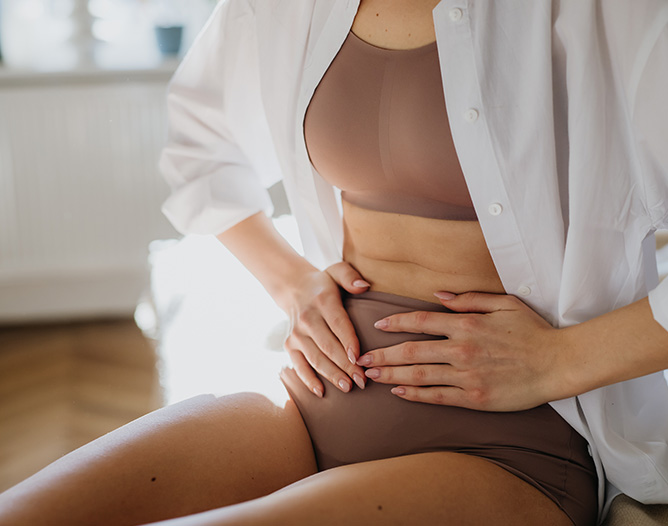Quick Links
Menstrual cramps can range from a dull ache to completely debilitating. While they are something we often feel like we have to deal with, that’s not necessarily the case. With the help of our team at MAIA, cramps (or dysmenorrhea) don’t have to rule your life any longer.
What is Dysmenorrhea?
Dysmenorrhea is the medical term for painful menstrual cramps. It happens because your uterus contracts in order to shed its lining. The pain typically starts before your period and then goes away after a few days. The pain can range from mild to severe and can come with other symptoms like a feeling of pressure in the abdomen, nausea, fatigue, headache, and diarrhea.
There are two types of dysmenorrhea: primary and secondary.
- Primary dysmenorrhea: This type of menstrual cramps happens repeatedly and aren’t caused by another medical condition. Pain begins 1-2 days before bleeding begins and subsides in 2-3 days. This is the most common type of dysmenorrhea.
- Secondary dysmenorrhea: This type is caused by a specific medical condition like endometriosis, fibroids, abnormal pregnancy, or infection in your reproductive organs. This type of pain usually begins several days before your period and lasts until the bleeding stops.

What Causes Dysmenorrhea?
Menstrual cramps occur when a chemical called prostaglandin makes your uterus contract. Before and during menstruation, your prostaglandin levels are higher, causing the uterus to contract much more strongly. This is what leads to the pain and discomfort you feel right before your period begins. The higher the levels of prostaglandin, the more painful your cramps are likely to be. The levels decrease once your period starts, which is why cramping tends to ease a day or two after your period begins.
#1 GROUP OF GYNECOLOGISTS IN THE CHICAGO AREA!
Renowned Expertise
Dr. Wolowick and Dr. Mitchell are renowned for their exceptional expertise and dedication to patient care. Their comprehensive knowledge and innovative approaches have consistently led to outstanding treatment outcomes. Patients and colleagues alike deeply appreciate their commitment to advancing medical practice and improving patient well-being.
Meet The Team

If you’re struggling with secondary dysmenorrhea from another medical condition, the pain can be caused by the following:
- Endometriosis: Tissue that acts similar to the lining of the uterus grows outside of the uterus, most commonly on fallopian tubes, ovaries, or the tissue lining your pelvis, which can cause intense pain
- Uterine fibroids: These noncancerous growths in the wall of the uterus can cause pain.
- Adenomyosis: The tissue that lines your uterus begins to grow into the muscular walls of the uterus and can lead to pain
- Pelvic inflammatory disease: This infection of the female reproductive organs is usually caused by sexually transmitted bacteria, and pain is one of the primary symptoms.
- Cervical stenosis: With this condition, the opening of the cervix is small enough to impede menstrual flow, causing painful pressure within the uterus.
Dysmenorrhea Treatment Options
There are a few different treatment options for dysmenorrhea. NSAIDs and other over-the-counter pain relievers like ibuprofen or acetaminophen work for some women as they are prostaglandin inhibitors, but others need stronger medications or even surgery.
Hormonal Medications
Hormonal birth control can often help lessen menstrual cramps. They work by suppressing ovulation and may reduce the amount of pain you feel before your period.
Lifestyle changes
There are a few simple changes you can make before or during menstrual cramps. Use a heating pad on your abdomen or lower back when you have cramps. Get as much rest as possible, avoid caffeine, cigarettes, and alcohol, and exercise regularly. Yoga and breathing exercises can be especially helpful for period cramps.
Surgical Options
There are several surgical options for dysmenorrhea, but they are usually only done when symptoms are particularly severe. These treatments include:
- Endometrial ablation: a procedure done to destroy the lining of the uterus
- Endometrial resection: a procedure done to fully remove the lining of the uterus.
- Hysterectomy: complete removal of the uterus
Frequently Asked Questions
What are the symptoms of dysmenorrhea?
Are there any factors that put someone more at risk for dysmenorrhea?
How is dysmenorrhea treated?
What are the differences between dysmenorrhea and regular period cramps?
How is dysmenorrhea diagnosed?
Can dysmenorrhea go away on its own over time?
What are the differences between dysmenorrhea and endometriosis?
How can dysmenorrhea be managed at home?
Can dysmenorrhea be a sign of a more serious condition?
Why does dysmenorrhea occur?
Schedule A Consultation
Find the relief you’re looking for from dysmenorrhea with the help of our experienced providers at MAIA! Dr. Wolowick and Dr. Mitchell will listen to your concerns, answer any questions you have, and build a treatment plan that meets all your needs. At MAIA, we happily serve residents in Chicago, Naperville, Downers Grove, and Aurora, IL.
Take the first step to better gynecological health and schedule a consultation today! Call our Downers Grove, IL office at 630-320-6703 or fill out our online contact form.




